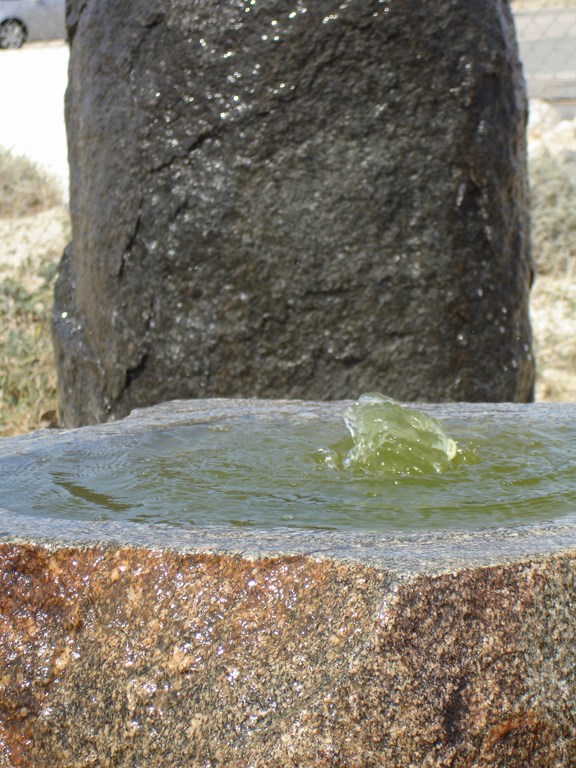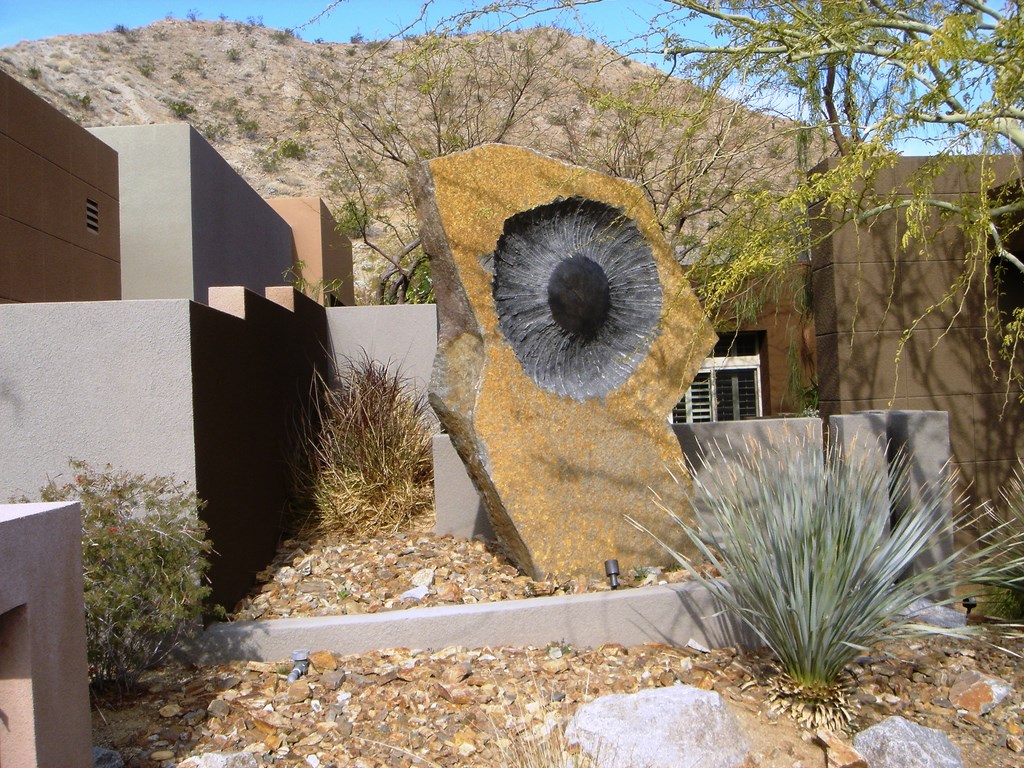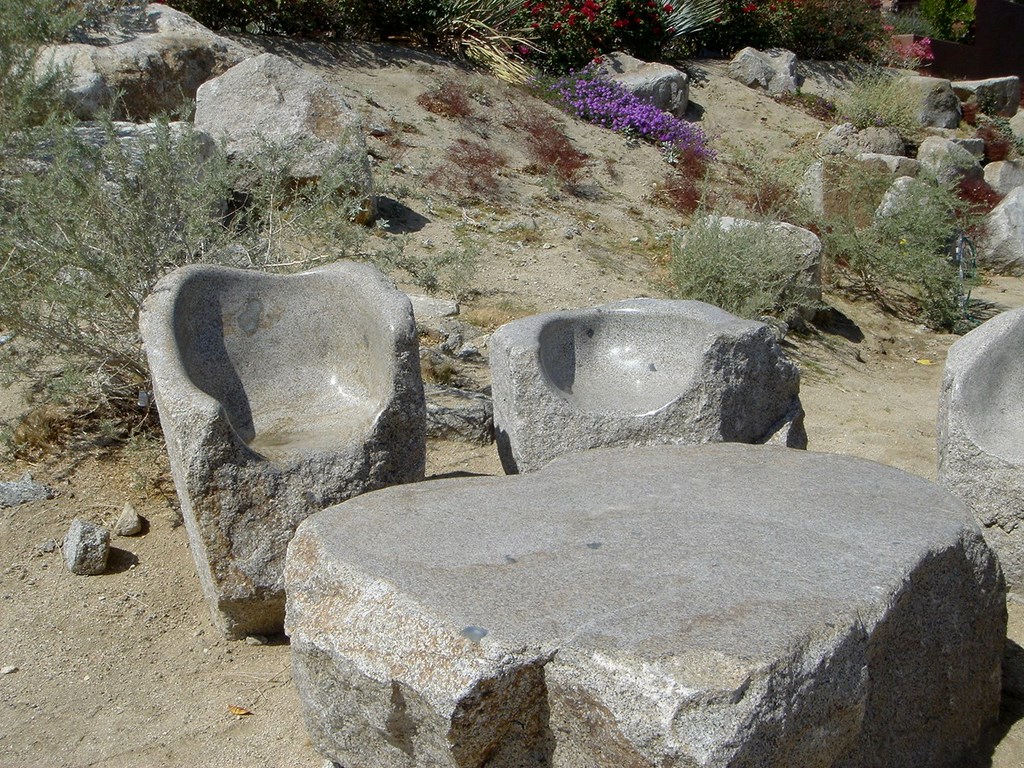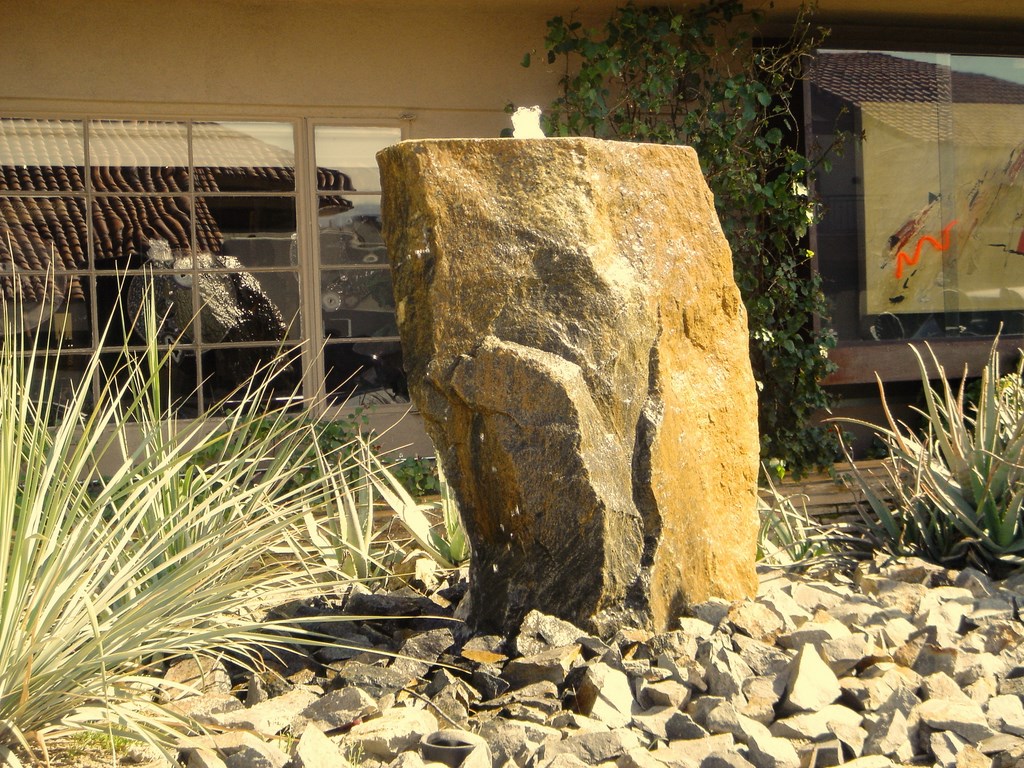Primitive Modern

I’ve always been conservative when it comes to guaranteeing my work, which is why I only offer a 300-year warranty on my sculptures. I’m fairly certain that the vast majority of my pieces will last well beyond that span, but there’s always the possibility one might be consumed by a volcanic eruption, blown up in disaster of some sort or drowned when the ice caps melt and cover the land with water.
Those sorts of cataclysms aside, it’s hard to imagine that the massive pieces of stone I use to create what I call “primitive modern” art will be compromised by much of anything the environment or human beings can throw at them.
Ultimately, that’s one of the beauties of working in stone: It possesses a profound form of permanence – and there’s a certain comfort that comes with knowing my work won’t be blown away by wind, eroded by rain or damaged by extremes of heat or cold. And given the fact that these pieces are so darn heavy, it’s safe to say that most people are going to think at least twice before trying to move or abscond with them.
Beyond the personal guarantees and despite the fact I don’t dwell on too much, working with stone also has a unique ability to connect me and my clients with both the very distant past and the far distant future. Human beings have been carving stone for thousands of years, and many of those works are still with us in extraordinarily representative shape. There’s little doubt that those pieces as well as those being created by stone artists today will be around far longer than we might care to imagine.
STANDING IN AWE
Something I do think about quite often is the sheer majesty and beauty of stone as it appears in our natural world and as it is used in human-influenced settings.
Stone is absolutely the most enduring of artistic and architectural materials. It’s the bones of even modest gardens and the flesh of the world’s largest and most enduring structures. Since the dawn of the human experience, we’ve hidden among stones for protection, shaped it into primitive of tools and used it to create the first known works of art.
All of this is why I’ve spent a lifetime falling in love and staying in love with stone. In working with it, I find the most elemental of connections to nature and human history. That may seem pretentious, but when you’re covered in dust, sweat, scrapes, cuts and bruises and cursing a chunk of rock you’ve been cutting, sawing, hammering, chiseling and cajoling for days, the fundamental nature and connectedness of stone becomes painfully real.
| In releasing the images bound into stones, I particularly enjoy the interplay of textures and the contrasts that emerge when I smooth certain parts of a boulder while leaving adjacent sections either rough or unfinished. This also occasionally gives me the opportunity to introduce color into my work in unique and unexpected ways. |
I wouldn’t go so far as to say that, through stone, we actually come to know the people who touched it in the distant past as some form of creative expression, but we do gain a sense of continuity in our lives and a connection with the natural world. In purely artistic terms, that is why stone is so evocative: When that potency is matched with plant material and water in a well-conceived space, we compose a setting that deeply affects other people – a fact I find endlessly intriguing and exciting.
Sculpting stone is, however, anything but an ethereal artistic experience. In many ways, in fact, it’s more like an endurance test.
When I look at a boulder, I try to imagine what image or form lies within it and then figure out how to release that image or form in a way that’s economical not only with respect to the cost of the piece to a client, but also my own time and the limitations of my equipment. I draw up a battle plan and go to work knowing that I’m not going to win on the first day. It takes real strength to do this, and not just strength of arm, leg and sinew, but also strength of will.
Through the years I’ve smashed, broken and otherwise injured so many parts of my body that I don’t keep track anymore, and I’ve probably inhaled enough stone dust to choke a herd of pack mules. If I’ve shortened my own number of days on this planet because of that struggle, I’d have to say it was a sacrifice well made. Plus, it sure beats working behind a desk in some office somewhere.
STUDIES IN CONTAST
It’s self-evident that in any creative medium, the artist, designer or craftsperson has a certain range of possibilities in working with a material, sound or light. With stone, that range is actually fairly limited: Basically, there’s the skin of the stone and all the things you can do with it below the surface. Beyond that, it’s about textures, shapes and the negative spaces revealed by removing portions of the original mass.
Personally, most everything I do with stone is intended in one way or another to exploit some sort of contrast.
| The sensations I convey by managing textures become even more pronounced when water is introduced to a composition. The motion of the water can be used to highlight changes in texture – or simply to wash across a rough surface to create a shimmering, sparkling spectacle. |
The majority of my pieces have portions of the boulder that are left untouched in order to establish juxtapositions with a range of carved shapes, contours, textures and voids. I play it this way this for two basic reasons: First, it’s hard to improve on the raw beauty of nature, and I’m perfectly happy to let that splendor take the lead for some or all of an art piece. Second, to take a chunk of stone and completely transform it into something else the way Michelangelo did, for example, is a huge amount of work. Compared to someone like him, I’m basically a lazy person.
|
Desert Solitaire Living and working in the desert has been a life-changing experience for me. It’s hot, dusty and forsaken, but it’s also among the most beautiful natural settings I’ve ever encountered. I moved out here for a variety of reasons (as described briefly in another sidebar below), but the principal lure was the amazing black granite found in the region’s quarries – that, plus the fact that land was inexpensive enough that I could set up shop in wide-open spaces that left me to enjoy the desert itself. Out here, you learn to live with the heat, even enjoy it – although you do have to drink lots of water and avoid going in and out of air-conditioned spaces too often. In my case, I’ve learned to live at night in all new ways under rivers of stars. You can really get caught up in the majesty of the firmament, the plaintive cries of the coyotes and the sounds and sensations of the warm wind. It’s understandable why so many artists, writers and philosophers have found inspiration in such places. The scenery speaks for itself, but there’s also a culture and lifestyle here unto itself. Since I’ve settled in, I’ve met all sorts of fascinating, intellectually diverse characters, all seemingly united by a sort of fierce individualism. There’s a freedom and expansiveness of mood and emotion, and all sorts of great nightspots, too. It’s no small thing that there are very few local pleasures more satisfying than an ice-cold margarita after a long day of sweating it out in the hot sun: They just seem to taste better out here. — R.H. |
So instead of transforming stone into something it’s not, I use the rugged, aged and wild surfaces I find to create a form, figure or space that will draw the interest of the viewer and create a perception of artistic value. That may simply mean polishing part of the surface to call out a contrast with the rough, natural surface. Or it may involve cutting away a large part of the boulder or incising the surface with geometric or organic figures. Many of my pieces feature voids, holes and portals I’ve drilled into the stone to invoke a dramatic contrast between air and light and the unyielding material.
In some works, I challenge the boundary of what is and isn’t art by simply arranging unaltered boulders in an artistic way – or finding one I think is interesting enough as is and maybe setting it up on its end. I’m intrigued by the idea that, with the right piece of stone, the art is solely about selecting, orienting and placing the object in a landscape.
I have several projects that have consisted of multiple boulders set on end. I call these my “standing stones,” and they’re usually pieces I find at a quarry that might be half buried and basically discarded. When I perceive something in a boulder’s form, symmetry and aesthetic value, I’ll stand it up next to others in arrangements that create a collective object of beauty and majesty (think Stonehenge, for example).
Whether or not these assemblages qualify as “art” is almost irrelevant: In these cases, the stones themselves define the aesthetic value, whatever label is applied.
FUNCTIONAL FORMS
What’s happening in all of these cases is that I’m trying to be aware enough about what I’m doing to take my design cues from the material itself. I recently found this nearly round boulder, for example, and decided the best thing to do would be to cut it in half and turn it into a pair of hot-water spas. The sculpture in this case is in the internal contours that make the pieces functional – a completely different approach compared to the standing stones, but one that is equally determined by the character of the raw material.
In the case of the spas, it’s an expression of a delightful form of contrast in that I’ve created something useful in a way the average observer wouldn’t expect – at least not from a massive boulder. There’s always the possibility that other hot tubs have been carved entirely out of stone – indeed, it wouldn’t surprise me at all, and I can only think that the people who created them must be as obsessed as I am.
There’s something playfully impractical about transforming boulders into common objects: Not only does it embody contrast in a wonderfully intellectual way, but it also creates value and interest. True, one might argue that a four-person spa that weighs five tons (empty!) is impractical. The irony is, this is exactly what makes these pieces interesting so long as the owners don’t plan on moving them very often.
| Observers tend to have lots of preconceived notions when it comes to the way stone should be used, and I like to play with those expectations by creating pieces that are functional in unusual ways or that take on surprising organic forms. |
I’ve done the same sorts of things in making everyday objects such as tables and chairs out of stone. I’ve also fashioned fire rings, fireplaces, sinks, drinking fountains, signage, pathways, gateways and other items from stone.
To a large extent, everything I do is informed by my experiences in developing landscapes for clients. For many years, I specialized in creating naturalistic gardens and watershapes in a wide spectrum of residential and public settings. Although that’s not my focus now as it was when I first wrote for WaterShapes in 1999 (see “Classic Rock” in the April 1999 issue, page 18), that experience gave me a keen understanding of what people want in their gardens and has helped guide my work.
Back then, I found that in many cases the landscaping was actually the last thing that was to happen in a long line of sometimes-traumatic construction processes, especially in remodeling jobs. By the time I arrived to do my work, clients tended to be fairly well burnt out, so I was always sensitive to a need to make them feel comfortable. In the years since, I’ve found that functional art is a terrific way to do just that, especially if the clients appreciate the contrast and ironies and are still capable of cracking a smile at the end of a long project.
It’s also helpful in the sense that the functionality of a given piece is a great way to draw people closer to an appreciation of its artistic aspects. They might at first see a stone table and chairs as a place to sit and have a meal or a glass of wine, but because it’s created as a piece of sculpture, at some point their perception will shift: They’ll find a piece’s deeper meaning and see its beauty on a different level.
WATER’S WAY
All of these functional items extend from my past life in landscaping and gardening, and the same is true of the variety of fountains I make. In fact, I look at these as the most functional of items. During my years in landscape design and installation, I was deeply involved in bringing water into gardens and created scores of ponds and streams of a variety of shapes, sizes and styles, all using natural stone as a key element.
If there’s any medium that might rival stone for its intrinsic beauty and interest, it has to be water. Water is as literally fundamental to our world as stone is, shares indescribable aesthetic values and, surpassing stone, is essential to life as we know it. When deployed as part of a stone sculpture, water adds its own unique beauty while providing what I consider to be the most dramatic and engaging of all possible contrasts.
| In some cases, I will simply arrange stones as I find them, “sculpting” them in these cases by virtue of arranging them in ways that make a statement, set up a meditative reflection or simply lend visual interest to a conventional landscape. |
The form of water, or its “shape” if you will, is as ephemeral and fleeting as a stone’s form is static. When you place those materials together, there’s a fantastic paradox at play.
Moving water animates the permanently unyielding, unmoving stone. The interplay of light in water moving over a stone surface creates ever-shifting visuals, while the sound of moving water is famously alluring, atmospheric, even hypnotic. To silent stones, water lends a voice.
|
California’s Black Rush For years, I lived and worked in the northeastern United States, but about seven years ago I made the move to southern California’s Coachella Valley and now operate a sculpture business on several acres of barren desert north of Palm Springs. It was obviously a major transition, one that changed my life and my work, and the main reason I undertook it was to gain ready access to black granite. The material is exceptionally hard, polishes beautifully and is almost impossible to find in large pieces elsewhere in the country. There’s a drama and permanence I find in this material that is entirely unique. From a design standpoint, the dark color – whether polished and mirror-like or left rough and raw – looks good in a huge range of settings, from naturalistic gardens to architectural applications. And I know whatever I fashion from it will stand the test of time. All of the work I do now involves various species of granite and basalt. Both are igneous materials borne of volcanic activity, and neither has changed since the crust of the planet formed millions of years ago. Most of the granite I use, black and otherwise, comes from quarries in California, while the basalt materials come from Washington State. All of these are heavy and can be found as extremely large pieces that have no cracks or other imperfections – just the lumpy raw material I need to inspire me to find what I can within rough exteriors. — R.H. |
Water is so crucial to life that providing a water source in the garden – even if it’s just a representation of water’s presence in a symbolic way – lends the entire space a feeling of comfort and relaxation. It draws attention, motivates people to approach and attracts birds and other animals, lending entirely different dimensions to the artwork and the space around it.
This is all nothing new, of course. It’s exactly why so many people want access to fountains, streams, ponds, pools and spas in their daily lives.
The watershapes I build these days tend to be centered on the concept of the urn or basin. Most are upright or standing stones with bowls cut into the top. The bowls well up with water that spills over the sides and is captured at the bottom for re-circulation. The heavy look of these rough-hewn pieces and the delicate flow of water sheeting over their surfaces represent true studies in contrast and subtlety.
I love the fact that these simple watershapes work across a wide range of settings. Here in the desert, where many of my pieces wind up these days, the presence of water flowing on the cusp of desolation adds yet another layer of interest and drama.
EXPERIENTIAL LAYERS
The great thing about sculpture and landscape art in general is that they mean different things to different people and can even have very different meanings for the same person depending upon how and when the experience occurs. With forms this intentionally abstract, you can never be sure how people will react or what they’ll think, if anything at all.
| Water is as fundamental to our existence as is stone, and I find that, by combining the two, these elements provide the most dramatic and engaging of all possible contrasts. There’s a joy to the way the water animates the unyielding, unmoving stone as it dances across variously textured surfaces. |
I’ve always been intrigued by the idea that my art pieces provide a different set of experiences depending on the observer’s physical proximity to them, how the pieces are situated relative to the traffic around them or by way of a their function in the landscape.
In my case, I’m working largely on an intuitive level that’s been influenced by years of backbreaking work with this material and the logistical, physical and practical challenges it presents. Just moving these things can be an enormous undertaking, but at the same time, I find the work and the gritty tasks associated with it to be endlessly inspiring.
For my part, I’m happy to let other people enjoy and find their own meanings in these pieces. So long as I can continue to work at uncovering stone’s elemental and primal nature, I’ll be cutting, hammering and chiseling away with a smile.
Roger Hopkins has been a stone sculptor and landscape artist in Palm Springs, Calif., for the past seven years. For the previous 30 years, he was a stonemason in Massachusetts, working on everything from modest dwellings to hundred-million-dollar estates. In that time, he developed a reputation for expertise that came to the attention of the producers of two PBS series, “This Old House” and “The Victory Garden,” on which he became a frequent participant. More recently, he served as a member of highly specialized design teams for the PBS science series “Nova,” where he and others tried to figure out how the Egyptian pyramids, obelisks and other large stone structures were built. Through the years, Hopkins developed his skills as a sculptor by installing at least one of his creations on every landscape job he designed and built. He now specalizes in sculptures that can be useful in homes or play major roles in any landscaped space.
.
.






















